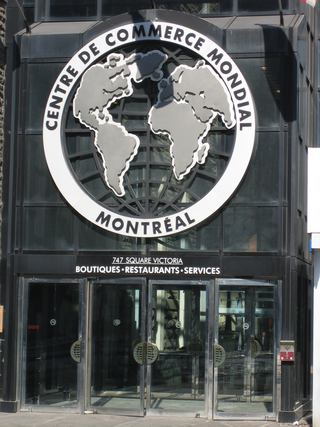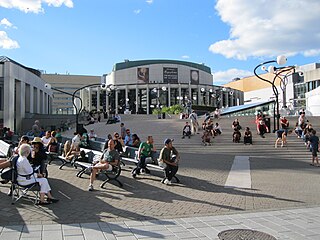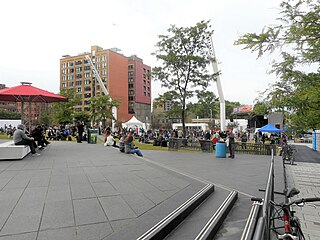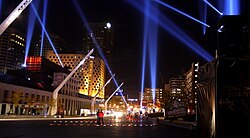
Place des Arts is a major performing arts centre in Montreal, Quebec, Canada, and the largest cultural and artistic complex in Canada.

Place-des-Arts station is a Montreal Metro station in the borough of Ville-Marie, Montreal, Quebec, Canada. It is operated by the Société de transport de Montréal (STM) and serves the Green Line. The station opened on October 14, 1966, as part of the original network of the Metro. It is located in the Quartier des spectacles district, in east-central downtown.

The Quartier Latin is an area in the Ville-Marie borough of Montreal, located east of the Quartier des Spectacles and west of the Centre-Sud and Village, centred around UQAM and lower Saint-Denis Street. It is known for its theatres, artistic atmosphere, cafés, and boutiques. It owes its name, a reference to the Quartier Latin in Paris, to the presence of the École Polytechnique de Montréal and the nascent Université de Montréal in the 1920s. In the 1940s the university moved out and headed for a new campus on the north slopes of Mount Royal, far from the downtown borough. In the late 1960s UQAM was born and established itself in the Ville-Marie borough, giving a modern underpinning to the name. A large junior college, the CEGEP du Vieux-Montreal also moved in at about the same period.

Ville-Marie is the name of a borough (arrondissement) in the centre of Montreal, Quebec. The borough is named after Fort Ville-Marie, the French settlement that would later become Montreal, which was located within the present-day borough. Old Montreal is a National Historic Site of Canada.

Saint-Henri is a neighbourhood in southwestern Montreal, Quebec, Canada, in the borough of Le Sud-Ouest.

The Quartier international de Montréal (QIM) or Montreal's International District is a district of the Ville-Marie borough in the city's downtown core of Montreal, Quebec, Canada. It is roughly bordered by René-Levesque Boulevard to the north, Notre-Dame Street to the south, De Bleury/Saint-Pierre Street to the east and Robert-Bourassa Boulevard to the west. The Palais des congrès building lying just east of the district is also usually comprised in it. Constructed dispersedly between 1965 and 1985 in place of older colonial housing blocks, the district underwent major urban renewal as a central business district in 2000–2003.

Chinatown in Montreal is located in the area of De la Gauchetière Street in Montreal. The neighbourhood contains many Asian restaurants, food markets, and convenience stores as well being home to many of Montreal's East Asian community centres, such as the Montreal Chinese Hospital and the Montreal Chinese Community and Cultural Centre.

Saint Laurent Boulevard, also known as Saint Lawrence Boulevard, is a major street in Montreal, Quebec, Canada. A commercial artery and cultural heritage site, the street runs north–south through the near-centre of city and is nicknamed The Main, which is the abbreviation for "Main Street".

Sainte-Catherine Street is the primary commercial artery of Downtown Montreal, Quebec, Canada. It crosses the central business district from west to east, beginning at the corner of Claremont Avenue and de Maisonneuve Boulevard in Westmount, and ending at the Grace Dart Extended Care Centre by Assomption metro station, where it folds back into Notre-Dame Street. It also traverses Ville-Marie, passing just east of Viau in Mercier–Hochelaga-Maisonneuve. The street is 11.2 km long, and considered the backbone of Downtown Montreal.

Downtown Montreal is the central business district of Montreal, Quebec, Canada.

Salle Wilfrid-Pelletier is a large multipurpose venue in Montreal, Quebec equipped with sophisticated technical equipment. It seats 2,982 people and is part of the Place des Arts cultural complex in Montréal's Quartier des Spectacles entertainment district. It is the largest multipurpose stage in Canada.
Montreal was referred to as "Canada's Cultural Capital" by Monocle Magazine. The city is Canada's centre for French-language television productions, radio, theatre, film, multimedia, and print publishing. The Quartier Latin is a neighbourhood crowded with cafés animated by this literary and musical activity. Montreal's many cultural communities have given it a distinct local culture.

The Musée d'art contemporain de Montréal (MACM) is a contemporary art museum in Montreal, Quebec, Canada. It is located on the Place des festivals in the Quartier des spectacles and is part of the Place des Arts complex.
Begone Dull Care is a 1949 visual music animated film directed by Norman McLaren and Evelyn Lambart for the National Film Board of Canada (NFB).
Montréal 2025 is the modernization plan for the city of Montreal with innovative and avant-garde projects. Those include the Quartier des Spectacles and the Quartier de la Santé.

The Red-Light District of Montreal, Quebec, Canada was formerly centred on the intersection of Saint Laurent Boulevard and Saint Catherine Street in the borough of Ville-Marie.

Dare-Dare, stylized DARE-DARE, is an artist-run center and a nonprofit organization located in Montreal. It was founded by Sylvie Cotton and Claire Bourque. Its offices are located in a construction trailer, decorated by artists and stationed in different districts on the island of Montreal. The name given by the center to these successive temporary locations is Dis/location: urban articulation project.
Les Compagnons de Saint-Laurent was a theatre company that was founded in August 1937 at Collège de Saint-Laurent in Saint-Laurent, Quebec, by Émile Legault, Roger Varin, and Léonide Lavinge. According to The Canadian Encyclopedia it was the "[...] most influential theatrical company in the history of Québec". The company dissolved in 1951.

Le Parterre, originally called Place de l'Adresse-Symphonique, is a public square in the Quartier des spectacles district in Montreal, Quebec, Canada. This space in front of the Maison symphonique de Montréal is intended as a performance space for different musical ensembles, as well as a setting for highlighting the architecture of the symphony house.



![Promenade des Artistes [fr]. FIJM 2013 - 125.jpg](http://upload.wikimedia.org/wikipedia/commons/thumb/8/86/FIJM_2013_-_125.jpg/220px-FIJM_2013_-_125.jpg)















